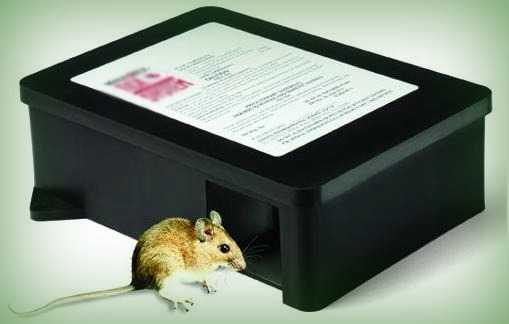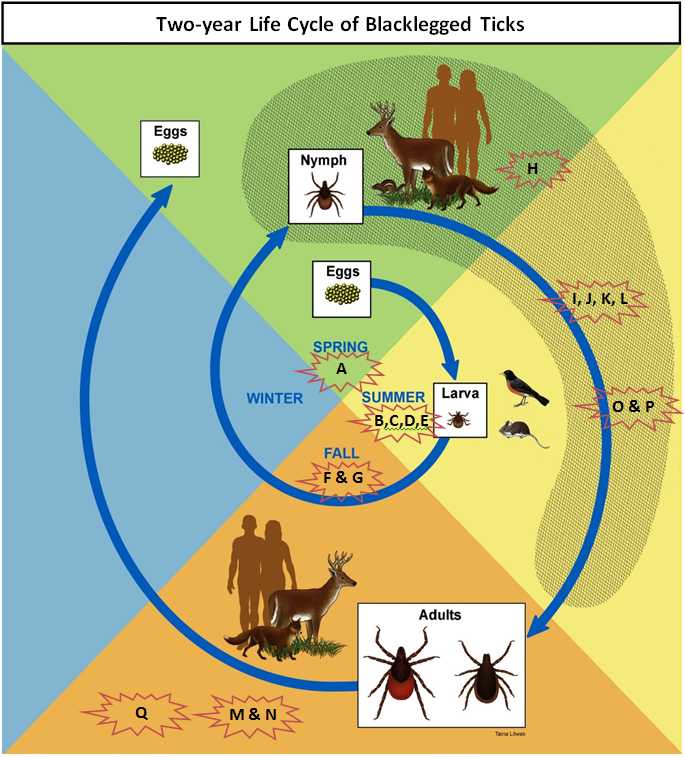Bait Box Study (Connecticut)
Enrollment for the 2013 Bait Box Study has ended.
Thank you for your interest. Enrollment for the 2013 Bait Box Study has ended, and we are no longer accepting new participants. If you were enrolled in the study in the spring of 2012, some of the dates and information presented here may not apply to you. Please call us at 855-BAITBOX if you have any questions.
The Connecticut Emerging Infections Program, the Connecticut Department of Public Health, Western Connecticut State University, and the Centers for Disease Control and Prevention are conducting a study to investigate whether tickborne diseases can be prevented with the use of commercially available, SELECT TCS™ Tick Control System bait boxes, a rodent-targeted method of tick control. Participants in this study will be asked to allow bait boxes to be placed on their properties by Connecticut Tick Control, a licensed pest control company. Participants may either have “active” boxes (bait boxes with pesticide) OR “placebo” boxes (bait boxes without pesticide) placed on their properties. The group participants are in will be chosen at random.
The bait boxes contain bait that is attractive to mice and either a pesticide-soaked wick, or no wick. Mice enter the boxes through a small opening. If the box is “active,” mice move through the box and pass under a small wick. The wick will lightly brush the mouse and gently apply a very small amount of low-dose fipronil, an EPA-registered pesticide that is effective against ticks. The fipronil won’t harm the mouse or any other animal that might touch or eat it, but it will kill the ticks on the mouse.
Information about Fipronil

Mice, attracted by the bait inside the box, enter. Inside, an overhanging wick applies fipronil to the mouse's back.
- The chemical in this study used to control ticks is fipronil, an EPA-registered pesticide. This is the active ingredient in many flea and tick control products (e.g., Frontline®) used on pets.
- The amount of fipronil in the bait boxes is 10 times less than that found in products used on pets.
- The risk of coming into contact with the wick containing this chemical is very low, because it is hidden deep inside the rodent bait box.
- The box is child-resistant and cannot be opened.
- The National Pesticide Information Center has a Fipronil Fact Sheet.
Frequently asked study questions/concerns/answers
Q: What is the goal of the study?
A: The study is designed to examine whether bait boxes, a rodent-targeted method of tick control, reduce the number of tick bites and the incidence of Lyme and other tickborne diseases.
Q: What is the study design?
A: The study will enroll up to 500 households in the spring of 2013. These households will be randomized into either a group that will receive bait boxes with pesticide (fipronil) or a group that will receive bait boxes without pesticide. These bait boxes will be placed on the properties of all participants in July of 2013. On average, between 6 and 10 boxes will be placed at the landscaping or wood-lawn interface (including front, back, and side yards) of participants’ homes. Study participants do not have to do anything regarding the bait boxes that are placed around their property. Study personnel will collect data through phone surveys about whether household members have had any ticks crawling on or attached to them and whether any household member has had a tickborne disease. These short surveys will take place twice a year until the study’s conclusion in 2015. Study participants will also be asked to fill out a week-long activity log in early June of 2013 that records their time spent outside.
Q: What will be asked of households that participate in this study?
A: There are three components of the study: 1) bait box placement and removal by a licensed pest control company, 2) surveys of study participants, and 3) collection of ticks from participants’ properties by researchers. Participants do not have to be present when the pest control company places or removes bait boxes from their property, but they can choose to be present if they would like. In July of 2013, the pest control company will come to their property and place bait boxes around the property. In October of 2013, the first round of bait boxes will be removed. In May of 2014, the second round of bait boxes will be placed on their property. In July of 2014, the second round of bait boxes will be replaced with the third round of bait boxes. In October of 2014, the third round of bait boxes will be removed.
In July of 2013, 2014, and 2015 ticks will be collected from a random sample of properties. If a participant’s property is selected for sampling, we will ask his or her permission at that time and tell him or her details about the process. Participants do not have to be present when study personnel collect ticks from their property, but they can choose to be present if they would like.
Q: How does the bait box work?
A: The bait box consists of three components: 1) a child-resistant rodent bait box, 2) nontoxic bait block, and 3) an applicator containing 0.7% fipronil. Rodents (mice and chipmunks) that enter the box to feed or investigate are treated with fipronil as they come in contact with the applicator wick. This pesticide kills the ticks on the mice at that time, and any ticks that come into contact with the mice for the next several weeks. This tick control method interrupts the transmission cycle of Lyme disease. In this study, half of the homes will receive bait boxes with a wick containing fipronil, and half will receive bait boxes without the pesticide.
Q: What is the nontoxic bait block?
A: The nontoxic bait block is composed of 25% paraffin wax, 25% oats, 20% flour, 20% wheat flour and 10% peanut butter/molasses.
Q: Will the bait box attract more mice to participants’ properties?
A: It is highly unlikely that the presence of the bait box on properties will increase the overall number of mice on participating properties. This is unlikely because rodents are very territorial. They stay in the same general area over the course of their life unless they are trapped or killed by predators.
Q: Will other rodents be attracted to my property?
A: The bait boxes will not specifically attract non-target animals. Medium sized mammals including feral cats, foxes, coyotes, and raccoons that are passing through an area with bait boxes will investigate the boxes. Since the bait boxes are tamper resistant, they will find that they are unable to open the boxes and then usually leave them alone.
Q: Is the chemical in the bait box dangerous?
A: The chemical in this study used to control ticks is fipronil, which is the active ingredient in many of the popular topical flea and tick control products (e.g., Frontline®) for household pets. The concentration of fipronil in the bait boxes is 10 times less than that found in topical flea and tick control products used on household pets. The likelihood of coming into direct contact with the wick containing this low-concentration fipronil is very low, because it is encased in a child-resistant rodent bait box. Fipronil is harmful if absorbed through the skin, inhaled, or swallowed. Health effects from a brief exposure to fipronil depend on how someone is exposed to the chemical. Direct, short-term contact with skin can result in slight skin irritation. Signs and symptoms from a brief exposure to fipronil generally improve and clear up without treatment.
Q: What if cats eat mice that have been in contact with the bait box?
A: It takes very little pesticide to control ticks on a small rodent, and the pesticide used in the bait box is an extremely low dose pesticide. The concentration of fipronil on the wicks that the mice move through in the bait box is 0.7% fipronil. The concentration of fipronil in the commonly used, veterinarian recommended, flea and tick control (e.g., Frontline®) is 9.8% fipronil. Therefore, the concentration of fipronil used in the bait boxes is 10 times less than the concentration found in commonly used topical flea and tick control products for household pets.
Q: Why not kill the rodent hosts?
A: Eliminating the hosts is not practical. During a study in Dutchess County, New York, all rodents were removed from a one-acre plot, but it was an enormous task. And, after the study was concluded, the rodent population rebounded within two months.
Q: What about all the other rodents present (e.g. squirrels)?
A: The white-footed mouse is by far the most important host for the Lyme disease bacterium. The eastern chipmunk and the meadow vole may also be important, and they are also treated by bait boxes. Squirrels are too large for the bait boxes, but they don’t appear to play a significant role in Lyme disease risk for humans.
Q: Don’t deer carry the disease, too?
A: Deer do not carry the disease, but they are involved in the spread of ticks. They range over very large areas and can deposit deer ticks in your lawn that they picked up elsewhere. Where deer populations are high, so are deer tick numbers and the possibility for tick and deer mouse interactions. Deer fencing and localized deer reduction programs may help reduce the risk of Lyme disease, but it isn’t known whether these are effective methods to prevent Lyme disease.
- Page last reviewed: December 2, 2015
- Page last updated: December 2, 2015
- Content source:


 ShareCompartir
ShareCompartir
